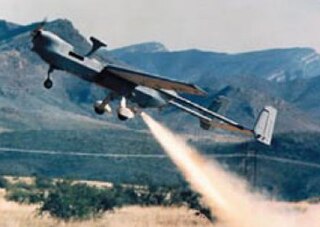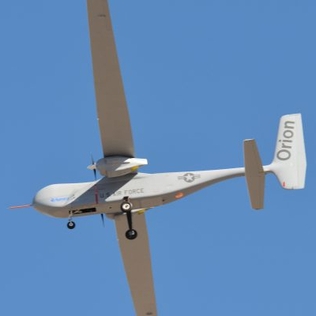Related Research Articles

The RQ-3 DarkStar is an unmanned aerial vehicle (UAV). Its first flight was on March 29, 1996. The Department of Defense terminated DarkStar in January 1999, after determining the UAV was not aerodynamically stable and was not meeting cost and performance objectives.

The IAI RQ-5 Hunter unmanned aerial vehicle (UAV) was originally intended to serve as the United States Army's Short Range UAV system for division and corps commanders. It took off and landed on runways. It used a gimbaled EO/IR sensor to relay its video in real time via a second airborne Hunter over a C-band line-of-sight data link. The RQ-5 is based on the Hunter UAV that was developed by Israel Aerospace Industries.

The AAI RQ-7 Shadow is an American unmanned aerial vehicle (UAV) used by the United States Army, Australian Army, Swedish Army, Turkish Air Force and Italian Army for reconnaissance, surveillance, target acquisition and battle damage assessment. Launched from a trailer-mounted pneumatic catapult, it is recovered with the aid of arresting gear similar to jets on an aircraft carrier. Its gimbal-mounted, digitally stabilized, liquid nitrogen-cooled electro-optical/infrared (EO/IR) camera relays video in real time via a C-band line-of-sight data link to the ground control station (GCS).

AAI Corporation is an aerospace and defense development and manufacturing firm, located in Hunt Valley, Maryland, US. Formerly a wholly owned subsidiary of United Industrial Corporation, AAI was acquired by Textron in 2007. It currently operates as a unit of Textron Systems and employs more than 2,000.

AeroVironment, Inc. is an American defense contractor headquartered in Arlington, Virginia, that designs and manufactures unmanned aerial vehicles (UAVs). Paul B. MacCready Jr., a designer of human-powered aircraft, founded the company in 1971. The company is best known for its lightweight human-powered and solar-powered vehicles. The company is the US military's top supplier of small drones —notably the Raven, Switchblade, Wasp and Puma models.

A miniature UAV, small UAV (SUAV), or drone is an unmanned aerial vehicle small enough to be man-portable. Smallest UAVs are called micro air vehicle.

The AeroVironment RQ-11 Raven is a small hand-launched remote-controlled unmanned aerial vehicle developed for the United States military, but now adopted by the military forces of many other countries.

Marine Unmanned Aerial Vehicle Training Squadron 2 (VMUT-2) is an unmanned aerial vehicle training squadron in the United States Marine Corps that is transitioning from operating the RQ-21A Blackjack to the MQ-9A Reaper. The squadron is based at Marine Corps Air Station Cherry Point in Havelock, North Carolina and will serve as the MQ-9A Reaper Fleet Replacement Squadron, training UAS officers and enlisted sensor operators. Historically, VMUT-2 provided aerial surveillance, offensive air support, and electronic warfare for the II Marine Expeditionary Force. VMUT-2 falls under the command of Marine Aircraft Group 14 and the 2nd Marine Aircraft Wing.
The 13th Aviation Regiment is a regiment of the United States Army.

The Northrop Grumman Bat is a medium-altitude unmanned air vehicle originally developed for use by the United States Armed Forces. Designed primarily as an intelligence "ISR" gathering tool, the Bat features 30 lb (14 kg) payload capacity that is unmatched in a 10 ft (3.0 m) wing span.

The Elbit Systems Skylark I and Skylark II are miniature UAVs developed by Elbit Systems. Initial models of the Skylark entered service in 2008.

A high-altitude platform station also known as atmospheric satellite is a long endurance, high altitude aircraft able to offer observation or communication services similarly to artificial satellites. Mostly unmanned aerial vehicles (UAVs), they remain aloft through atmospheric lift, either aerodynamic like airplanes, or aerostatic like airships or balloons. High-altitude long endurance (HALE) military drones can fly above 60,000 ft over 32 hours, while civil HAPS are radio stations at an altitude of 20 to 50 km above waypoints, for weeks.

The AeroVironment Wasp III Small Unmanned Aircraft System is a miniature UAV developed for United States Air Force special operations to provide a small, light-weight vehicle to provide beyond-line-of-sight situation awareness. The aircraft is equipped with two on-board cameras to provide real-time intelligence to its operators. It is also equipped with GPS and an Inertial Navigation System enabling it to operate autonomously from takeoff to recovery. It was designed by AeroVironment Inc., and was first added to the Air Force inventory in 2007. There are two Wasp variants: the traditional version that lands on land, and a version that lands into the sea or fresh water. The Air Force accepted the Wasp AE in late May 2012, and the U.S. Marine Corps revealed in January 2013 that they had ordered the Wasp AE. The Wasp AE is designated as the RQ-12A.

The AeroVironment T-20 unmanned aerial vehicle (UAV) is a medium range, composite aircraft capable of internal and external payloads. Launched from a portable catapult, it can be recovered with a shipboard landing system, or belly land on unimproved surfaces. The T-20 carries a retractable gimbal-mounted, digitally stabilized, electro-optical/infrared (EO/IR) camera that relays video in real time via a C-band LOS data link to the ground control station (GCS). Powered by a 4-stroke, fuel injected gasoline engine, the aircraft burns 2 lb (910 g) of fuel per hour at cruise. AeroVironment, Inc. acquired Arcturus UAV, the original developer of JUMP 20 and T-20 on February 22, 2021.

The AeroVironment RQ-20 Puma is an American unmanned aircraft system which is small, battery powered, and hand-launched. Its primary mission is surveillance and intelligence gathering using an electro-optical and infrared camera. It is produced by AeroVironment.

The Boeing Insitu RQ-21 Blackjack, company name Integrator, is an American unmanned air vehicle designed and built by Boeing Insitu to meet a United States Navy requirement for a small tactical unmanned air system (STUAS). It is a twin-boom, single-engine monoplane, designed as a supplement to the Boeing Scan Eagle. The Integrator weighs 61 kg (134 lb) and uses the same launcher and recovery system as the Scan Eagle.
The Northrop Grumman RQ-180 is an American stealth unmanned aerial vehicle (UAV) surveillance aircraft intended for contested airspace. As of 2019, there had been no images or statements released, but growing evidence points to the existence of the RQ-180 and its use in regular front-line service. The use of the nickname "White Bat" in a 2021 video released by the US Air Force Profession of Arms Center of Excellence (PACE) suggests that the military may be preparing to release information on the RQ-180.

As of January 2014, the United States military operates a large number of unmanned aerial vehicles : 7,362 RQ-11 Ravens; 990 AeroVironment Wasp IIIs; 1,137 AeroVironment RQ-20 Pumas; 306 RQ-16 T-Hawk small UAS systems; 246 MQ-1 Predators; MQ-1C Gray Eagles; 126 MQ-9 Reapers; 491 RQ-7 Shadows; and 33 RQ-4 Global Hawk large systems.

The Orion is a Medium-altitude long-endurance unmanned aerial vehicle (UAV) developed by Aurora Flight Sciences.
References
- ↑ Department of Defense. "Unmanned Aircraft System Airspace Integration Plan" (PDF). Archived from the original (PDF) on 2016-01-21. Retrieved 2015-08-06.
{{cite journal}}: Cite journal requires|journal=(help) - ↑ U.S. Army. ""U.S. Army Roadmap for UAS 2010-2035"" (PDF). Retrieved 2015-08-06.
{{cite journal}}: Cite journal requires|journal=(help) - ↑ Chairman of the Joint Chiefs of Staff. "Joint Unmanned Aircraft Systems Minimum Training Standards" (PDF). Archived from the original (PDF) on 2015-09-06. Retrieved 2015-08-06.
{{cite journal}}: Cite journal requires|journal=(help) - 1 2 Department of Defense. "Unmanned Aircraft System Airspace Integration Plan" (PDF). Archived from the original (PDF) on 2016-01-21. Retrieved 2015-08-06.
{{cite journal}}: Cite journal requires|journal=(help) - 1 2 "MCCDC, MCSC - Coordinated UAV Endorsement Brief". Archived from the original on June 25, 2008. Retrieved August 8, 2008.
- ↑ Office of the United States Secretary of Defense. "UAV Roadmap 2005–2030" (PDF). Retrieved 2007-08-24.
{{cite journal}}: Cite journal requires|journal=(help) - ↑ [ dead link ]
- ↑ "Unmanned Aerial Vehicles". Archived from the original on January 11, 2012. Retrieved January 12, 2012.
- ↑ Comparison of USAF Tier II, II+ and III- systems Archived August 19, 2007, at the Wayback Machine
- ↑ USAF Tier system Archived May 14, 2006, at the Wayback Machine
- ↑ [ permanent dead link ]
- ↑ "AeroVironment, Inc.: AV Press: United States Marine Corps Awards AeroVironment $19.3 Million BATMAV Contract for Wasp III Micro Unmanned Aircraft Systems". Archived from the original on December 8, 2008. Retrieved March 19, 2015.
- ↑ "Navy League of the United States - Citizens in Support of the Sea Services". Archived from the original on February 7, 2012. Retrieved August 8, 2008.
- ↑ USMC RQ-7 Shadow Homepage
- 1 2 "Defense Tech: FCS Watch Archives". Archived from the original on August 11, 2007. Retrieved August 24, 2007.